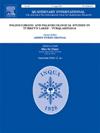Treeline history in Northwestern Chukotka during the Last Interglacial and Holocene
IF 1.9
3区 地球科学
Q3 GEOGRAPHY, PHYSICAL
引用次数: 0
Abstract
The fluctuations of the forest/tundra boundary are among the most significant indicators of climate change in the Arctic. The most reliable information regarding the historical position of this boundary is obtained through spatial-temporal analysis of wood remains collected from permafrost deposits. We conducted extensive research in the tundra zone of northwestern Chukotka, aiming to establish a comprehensive collection of fossil wood samples; to identify these samples to the genus/species levels; and to date samples through radiocarbon dating (over 60 dates) and uranium-thorium methods.
Our findings demonstrate that trees extended into the present tundra zone in the Rauchua-Chaun Lowland at least twice during the Last Interglacial and the Holocene. During the Last Interglacial (MIS-5), larch forests (taiga) interspersed with birch were prevalent in what is now tundra. In the early Holocene (11,000–8700 cal BP), riparian forests featuring willow, сhosenia, and poplar, along with tree birch, thrived in river valleys.
末次间冰期和全新世楚科奇西北部的树线历史
森林/冻土带边界的波动是北极气候变化的最重要指标之一。关于这一边界的历史位置的最可靠信息是通过对从永久冻土沉积物中收集的木材遗骸进行时空分析获得的。我们在楚科奇西北部的冻土带进行了广泛的研究,旨在建立全面的木材化石样本收集;将这些样本鉴定到属/种水平;并通过放射性碳定年法(超过60个年代)和铀钍法测定样品的年代。我们的研究结果表明,树木在末次间冰期和全新世至少两次延伸到现在的罗楚川低地冻土带。在最后一次间冰期(MIS-5),落叶松森林(针叶林)与桦树点缀在现在的冻土带普遍存在。在全新世早期(距今11000 - 8700 cal BP),以柳树、柞树、杨树和桦树为特色的河岸森林在河谷中繁盛。
本文章由计算机程序翻译,如有差异,请以英文原文为准。
求助全文
约1分钟内获得全文
求助全文
来源期刊

Quaternary International
地学-地球科学综合
CiteScore
5.60
自引率
4.50%
发文量
336
审稿时长
3 months
期刊介绍:
Quaternary International is the official journal of the International Union for Quaternary Research. The objectives are to publish a high quality scientific journal under the auspices of the premier Quaternary association that reflects the interdisciplinary nature of INQUA and records recent advances in Quaternary science that appeal to a wide audience.
This series will encompass all the full spectrum of the physical and natural sciences that are commonly employed in solving Quaternary problems. The policy is to publish peer refereed collected research papers from symposia, workshops and meetings sponsored by INQUA. In addition, other organizations may request publication of their collected works pertaining to the Quaternary.
 求助内容:
求助内容: 应助结果提醒方式:
应助结果提醒方式:


